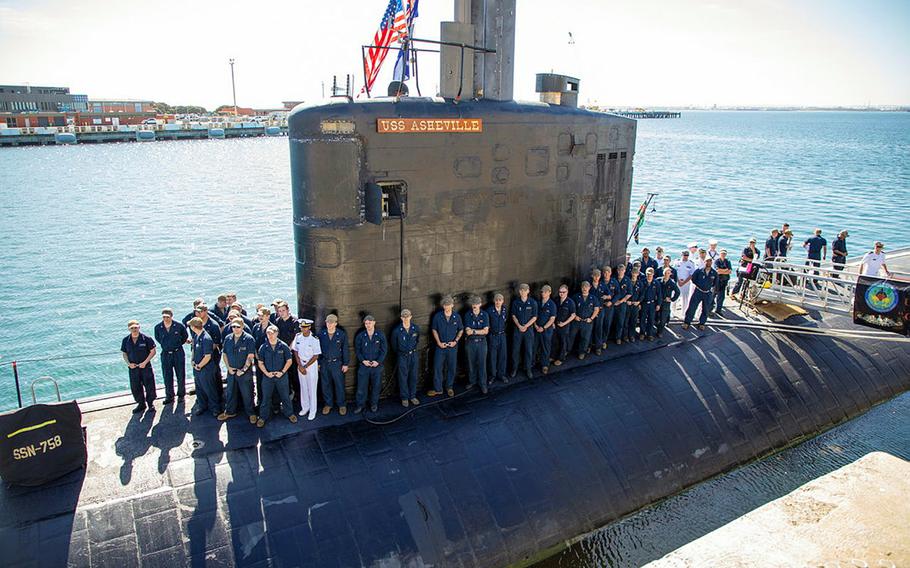
USS Asheville sailors assemble atop the submarine in this undated photo taken during their recent visit to HMAS Stirling in Western Australia. (Australian Department of Defence)
U.S. and British nuclear-powered submarines will maintain a continuous presence in Western Australia to train Australian sailors ahead of the country’s purchase of its own fleet of eight nuclear subs, say defense researchers.
The leaders of the AUKUS allies — President Joe Biden, Australian Prime Minister Anthony Albanese and U.K. Prime Minister Rishi Sunak — unveiled the submarine deal Monday, part of an effort to counter Chinese expansionism in the Indo-Pacific.
Under the deal, Australia aims to launch its nuclear-powered subs in the 2030s. A rotational force of U.S. and British subs will operate from Western Australia starting in 2027.
The agreement means a probable, rapid increase in U.S. submarine port calls Down Under, according to Ross Babbage, a former Australian assistant defense secretary.
“The tempo is likely to increase almost immediately,” he said by email Wednesday.
U.S. submarines in recent years have made routine port calls in Australia to resupply and train with local forces, Paul Buchanan, a U.S. security expert based in New Zealand, said in an email the same day.
A stop by the USS Asheville, a Los Angeles-class fast attack submarine, at HMAS Stirling in Western Australia was announced March 1 by the U.S. Embassy in Canberra.
Australia needs to double and probably triple the number of submariners in its navy, Babbage said.
A class of Australian submariners recently joined the U.S. Navy’s Nuclear Power School in Goose Creek, S.C., with another class scheduled to join later in the year, Buchanan said.
“The first class will then join active US subs as part of their ongoing training, as will the classes that follow them,” he said.
Australian submariners will likely be attached to Submarine Group 7, headquartered at Yokosuka Naval Base, Japan, with submarines homeported on Guam, Buchanan said.
“The Australian crews will need training in nuclear propulsion, maintenance and safety as well as operating cruise missiles from vertical launchers,” he said.
Australia will need to train between 120 and 320 submarine specialists to crew its new vessels, Buchanan added.
One British and four U.S. subs have been designated for Submarine Rotational Force West, which will mean two-month training visits to the port by each vessel starting in 2027, Buchanan said.
“Australian sailors will deploy on UK and US boats to develop at-sea experience with naval nuclear propulsion, while Australian maintenance personnel will support these submarines at shore,” the Australian Defence Department states on its website about the new force.
U.S. submarines headed to Western Australia will likely come from Guam since Submarine Group 7 is the command for the Western Pacific, Indian Ocean and Arabian Sea, Buchanan said.
The group’s Guam-based subs include the USS Key West, USS Asheville, USS Jefferson, USS Annapolis and USS Springfield.
“It is also possible that subs from Pearl Harbor will be rotated,” Buchanan said.
The U.S. Indo-Pacific Command did not respond to inquiries about the AUKUS deal by phone and email Monday and Tuesday.
A spokesman for China’s Foreign Ministry panned the AUKUS partnership and the submarine deal Tuesday as “a typical Cold War mentality,” during a press briefing in Beijing.
“It will only exacerbate arms race, undermine the international nuclear non-proliferation regime and hurt regional peace and stability,” said spokesman Wang Wenbin. “Peace-loving countries have expressed grave concern and firm opposition.”